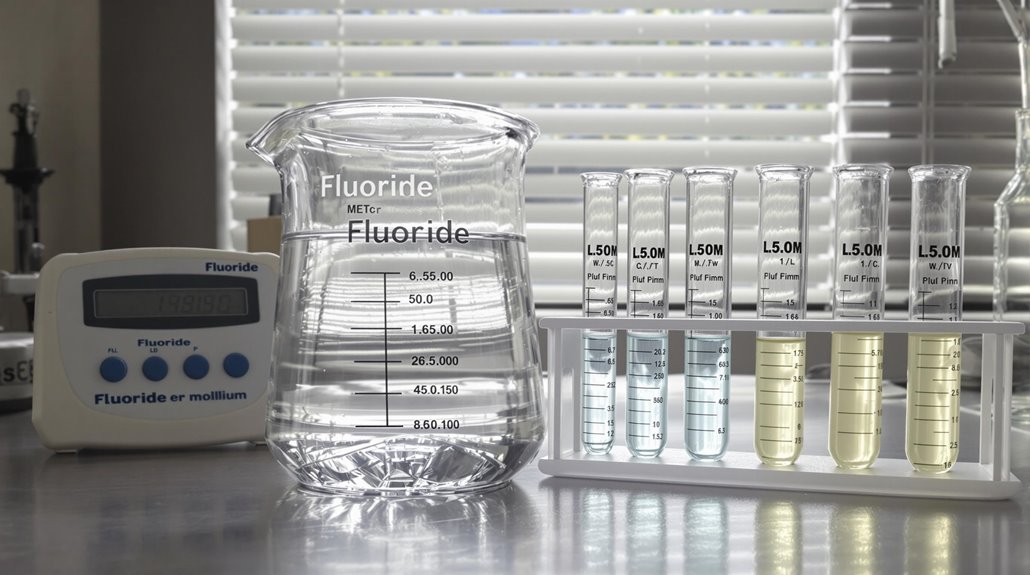You’ve likely consumed fluoridated water for years without realizing its complex history and impacts. While public health officials claim it reduces cavities by 20-40% and saves $38 in dental costs per dollar invested, recent studies link excessive exposure to dental fluorosis in 41% of adolescents and potential cognitive impacts. The truth spans both benefits and risks – from proven cavity prevention to concerning neurological findings that challenge decades of standard practice. The full story reveals why some nations embrace fluoridation while others now reject it.
The History of Water Fluoridation

The dawn of water fluoridation marks one of public health’s most controversial chapters. You’ll find its roots in the 1930s, when dentists noticed unusually strong teeth among residents in areas with naturally fluoridated water. The breakthrough led to Grand Rapids, Michigan becoming the first city to artificially fluoridate its water supply in 1945.
As you track the historical milestones, you’ll see how this practice quickly spread across America, despite fierce policy debates. By the 1960s, fluoridation had become standard practice in major cities, championed by the U.S. Public Health Service.
What started as a local experiment has evolved into a nationwide initiative affecting nearly 200 million Americans. Yet the controversy hasn’t subsided – instead, it’s spawned decades of heated discussions about personal choice versus public health benefits.
How Fluoride Works in Dental Health
While dental experts have long championed fluoride’s cavity-fighting powers, its actual mechanism proves far more fascinating than most realize.
You’ll find that fluoride actively disrupts harmful bacteria while promoting tooth remineralization benefits through a sophisticated biochemical process. It’s not just a simple coating – it’s transforming your enamel at the molecular level.
The enamel strengthening mechanisms work like a targeted defense system. When you consume fluoridated water, the mineral integrates into your tooth structure, creating fluorapatite crystals that are more resistant to acid attacks than your natural enamel.
You’re fundamentally upgrading your teeth’s natural armor. This process continuously reinforces your dental defenses, making your teeth considerably more resilient against decay than they’d be without fluoride exposure.
Current Fluoridation Standards and Practices
Since federal guidelines were established in 1962, public water systems across America maintain fluoride levels between 0.7 and 1.2 parts per million – a range you’d find remarkably precise for such a widespread public health initiative.
Here’s what you’ll encounter in different regions:
| Region | Fluoridation Policy | Community Participation |
|---|---|---|
| Northeast | Mandatory | High Compliance |
| Midwest | Optional | Mixed Engagement |
| Southwest | Limited | Low Implementation |
You’ll find that fluoridation policies vary considerably by state and municipality. While 73% of Americans receive fluoridated water, you’re likely unaware that implementation costs have tripled since 2000. Community engagement programs struggle to counter misinformation, yet public health officials maintain that fluoridation remains one of the most cost-effective preventive measures available, despite vocal opposition groups’ persistent challenges.
Scientific Evidence Supporting Fluoridation

Research spanning multiple decades has consistently validated fluoridation’s remarkable efficacy in preventing tooth decay. You’ll find that studies from prestigious institutions worldwide show a 20-40% reduction in cavities among populations with fluoridated water supplies.
The fluoride benefits are particularly striking in children and lower-income communities.
The evidence supporting water fluoridation as a public health measure is overwhelming. You’re looking at more than 3,000 peer-reviewed studies confirming its safety and effectiveness.
Major health organizations, including the WHO and CDC, have endorsed fluoridation based on this extensive research. The data shows you’ll save $38 in dental costs for every $1 invested in fluoridation programs.
These numbers aren’t just statistics – they represent millions of people who’ve avoided painful dental procedures and costly treatments.
Potential Health Concerns and Criticisms
While fluoride’s beneficial dental effects are widely promoted, you’ll find mounting evidence about concerning side effects that stakeholders rarely mention.
Studies have linked excessive fluoride exposure to dental fluorosis, a condition causing white spots and discoloration on teeth, affecting up to 41% of adolescents in fluoridated areas.
Recent research from prestigious institutions, including Harvard School of Public Health, suggests fluoride exposure during childhood may impact neurological development and potentially lower IQ scores by several points, prompting urgent calls for further investigation.
Fluorosis and Dental Effects
Dental fluorosis stands as one of the most visible and controversial side effects of fluoride exposure in drinking water.
You’ll notice fluorosis symptoms first appear as white streaks on teeth, often progressing to brown staining and pitted enamel in severe cases. The dental discoloration can range from barely noticeable to severe aesthetic problems that impact self-confidence and require costly cosmetic treatment.
While proponents argue that mild fluorosis is merely cosmetic, you’re facing a more complex reality.
Studies show that moderate to severe cases can weaken tooth structure and increase sensitivity. The American Dental Association acknowledges that 41% of adolescents show some form of fluorosis, with 3.6% experiencing moderate to severe cases.
You’re now witnessing a generation where the visible evidence of excessive fluoride exposure can’t be ignored.
Neurological Impact on Children
Recent studies from prestigious institutions have raised alarming concerns about fluoride’s impact on children’s cognitive development. Research published in major medical journals shows that higher fluoride exposure during pregnancy and early childhood correlates with lower IQ scores and neurodevelopmental delays.
You’ll find that children in highly fluoridated areas demonstrate measurable cognitive impairments compared to their peers in low-fluoride regions.
The findings aren’t just academic speculation. Nearly 70 human studies now link fluoride exposure to reduced cognitive function in children.
What’s particularly troubling is how these effects appear most pronounced during critical developmental windows. Your child’s brain development could be at risk even at levels deemed “safe” by current standards.
The evidence suggests it’s time to reassess what we’ve long considered a routine public health measure.
IQ and Cognitive Development
The debate surrounding fluoride’s effects on IQ has reached a breaking point in scientific circles. Recent studies from prestigious institutions suggest that excessive fluoride exposure during childhood may impact cognitive function and reduce intelligence quotient scores by 5-7 points.
You’ll find researchers divided on whether these findings warrant immediate policy changes. Data from a 2022 meta-analysis of 27 studies shows concerning trends in areas with high fluoride concentrations.
Children exposed to elevated levels demonstrate measurable decreases in memory retention and problem-solving abilities. You’re looking at potential long-term implications for workforce productivity and academic achievement.
Major developmental studies indicate that even slight variations in early childhood exposure could affect neural pathway formation. The economic impact of reduced cognitive capabilities across populations hasn’t been fully calculated, but projections suggest billions in lost productivity.
Global Perspectives on Water Fluoridation
While most developed nations carefully weigh the benefits and risks of water fluoridation, stark differences emerge in how countries approach this public health measure.
You’ll find that international policies vary dramatically, from complete rejection in most European nations to widespread acceptance in the United States and Australia. Cultural attitudes play a significant role in these decisions.
You won’t see fluoridated water in Germany, France, or the Netherlands, where officials cite concerns about individual choice and environmental impact.
In contrast, countries like Ireland and Singapore have embraced fluoridation, reporting significant improvements in dental health.
What’s particularly telling is how some nations, including Japan and Israel, have reversed their stance on fluoridation after decades of implementation.
They’ve opted instead for targeted fluoride programs that don’t involve mass water treatment.
Economic Impact of Fluoridation Programs

Despite significant upfront infrastructure costs, community water fluoridation programs deliver remarkable returns on investment. You’ll find that for every dollar spent on fluoridation, communities save $20-$60 in dental treatment costs. These economic benefits ripple through healthcare systems, insurance markets, and family budgets.
When you examine the data closely, you’ll see why health economists consistently rank fluoridation among the most cost-effective public health measures. A typical city of 50,000 residents invests about $20,000 annually in fluoridation infrastructure – yet generates over $1 million in cost savings through prevented dental procedures.
Local businesses benefit too, with fewer employee sick days and reduced insurance premiums. The math isn’t complicated: fluoridation programs pay for themselves many times over, while protecting public health at a fraction of treatment costs.
Alternative Sources of Fluoride
Beyond public water systems, fluoride enters your body through multiple channels – some intentional, others surprising.
You’ll find natural fluoride sources in everyday foods like spinach, grapes, and seafood. Tea leaves contain particularly high concentrations, especially black and green varieties.
Many dental products serve as deliberate fluoride alternatives, from toothpaste and mouthwash to prescribed supplements.
What you mightn’t realize is that fluoride’s also lurking in unexpected places. It’s in processed foods made with fluoridated water, non-stick cookware residue, and even some antibiotics.
Pesticide residues on conventionally grown produce can contribute to your daily intake as well. Understanding these various exposure points isn’t just academic – it’s essential for managing your total fluoride consumption, especially if you’re already receiving it through municipal water supplies.
Making Informed Decisions About Fluoridated Water
You’ll need reliable data to determine whether your tap water’s fluoride levels align with EPA safety standards, which can impact your household’s dental and overall health.
If you’re concerned about elevated fluoride content, you can install reverse osmosis or activated alumina filters that effectively remove excess fluoride from your drinking water.
For precise measurements and informed decision-making, consider purchasing an at-home fluoride testing kit or requesting a detailed water quality report from your local utility provider.
Understanding Fluoride Safety Levels
While fluoride serves as an essential tool for dental health, understanding safe exposure levels remains vital for informed water consumption choices.
The EPA has established a maximum contaminant level of 4.0 mg/L, yet mounting evidence suggests this threshold may be too high. You’ll find that fluoride exposure varies greatly across regions, with some communities exceeding safety guidelines by alarming margins.
Recent studies indicate ideal fluoride levels should fall between 0.7-1.2 mg/L.
You’re likely consuming additional fluoride through food, beverages, and dental products – a fact often overlooked in safety calculations. Testing reveals that 40% of adolescents now show signs of dental fluorosis, indicating widespread overexposure.
It’s important that you monitor your total daily fluoride intake, considering all sources, not just drinking water.
Filtering Your Tap Water
Despite the widespread availability of water filters, most consumers remain unaware that standard carbon filtration won’t remove fluoride from tap water.
You’ll need specialized purification methods like reverse osmosis, activated alumina, or distillation systems to effectively reduce fluoride levels.
Standard water filters primarily target chlorine, sediment, and some heavy metals – leaving fluoride largely untouched.
If you’re concerned about fluoride intake, you’ll want to verify your filter’s NSF/ANSI certification specifically for fluoride removal. Many manufacturers make misleading claims about their products’ capabilities.
To effectively filter fluoride, expect to invest $200-600 in a proper system.
Reverse osmosis units, while costly upfront, can remove up to 95% of fluoride.
Remember to factor in regular maintenance costs and filter replacements when making your decision.
Home Testing Water Quality
Before investing in expensive filtration systems, testing your water’s fluoride levels can prevent unnecessary purchases and help target the right solution.
You’ll find several EPA-certified home testing kits available online, ranging from $25 to $75, with varying degrees of accuracy and thoroughness.
Professional water quality analysis provides more reliable results but comes at a steeper price point, typically $100-300 per test. You’ll receive detailed reports identifying not just fluoride levels but also other potential contaminants.
Local health departments sometimes offer subsidized testing services, though wait times can stretch to several weeks. Don’t rely on color-changing strips alone – they’re notorious for false readings.
Document your test results systematically, including dates, times, and source locations. Regular testing every six months guarantees you’re making informed decisions about your water consumption.
Conclusion
You’ve seen the evidence – water fluoridation remains one of public health’s most cost-effective initiatives, despite vocal opposition. While concerns about fluoride toxicity aren’t baseless, they’re often overblown when compared to decades of research showing dental health benefits. You’ll need to weigh the minimal risks against proven cavity prevention that saves billions in dental costs. Make your choice, but remember – scientific consensus backs fluoridation’s safety and effectiveness.





